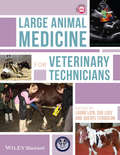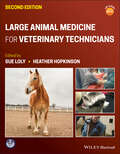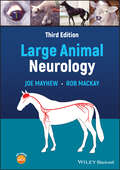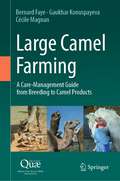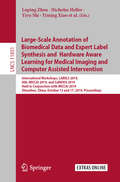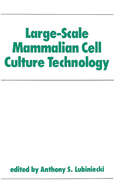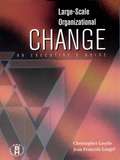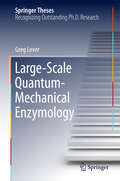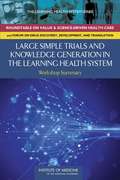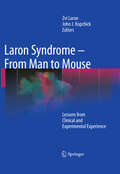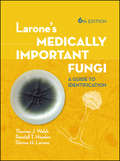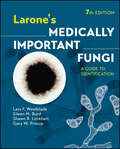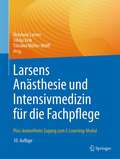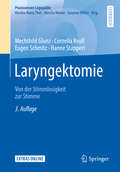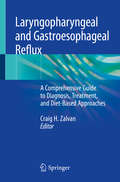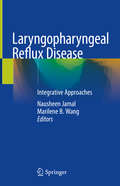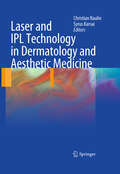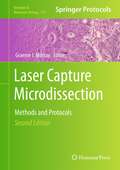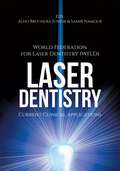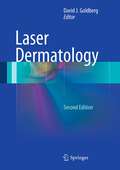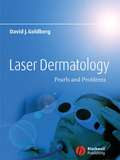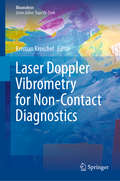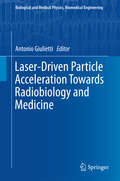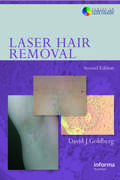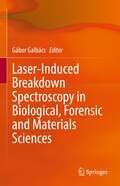- Table View
- List View
Large Animal Medicine for Veterinary Technicians
by Sheryl Ferguson Laura Lien Sue LolyThis comprehensive guide to all aspects of caring for horses, cattle, camelids, small ruminants, and pigs helps veterinary technician students learn everything they need to know about large animal medicine. Presented in full-color, Large Animal Medicine for Veterinary Technicians provides species-specific coverage with a wealth of images, as well as clinical applications. Coverage includes AVMA-required topics such as hospital biosecurity, restraint, physical examinations, nutrition, clinical and diagnostic procedures, reproduction, neonatology, and disease. To reinforce the text, an accompanying website offers review questions and answers, case studies, and an image bank with additional photographs to aid in breed identification. Veterinary technician students, veterinary technician educators, and veterinary technicians in practice who wish to foster and expand their knowledge of large animal medicine will find Large Animal Medicine for Veterinary Technicians an invaluable resource.
Large Animal Medicine for Veterinary Technicians
by Sue Loly Heather HopkinsonLarge Animal Medicine for Veterinary Technicians provides comprehensive guidance on caring for horses, cattle, camelids, small ruminants, pigs, and other farm animals. Reflecting the topics required by the American Veterinary Medical Association (AMVA), this practical resource covers hospital biosecurity, restraint, physical examinations, clinical and diagnostic procedures, reproduction, nutrition, disease, and more. Detailed chapters written by expert contributors contain numerous full-color images, clinical applications, self-review questions, and accurate, species-specific information. The second edition features revised and new content throughout, including brand-new chapters on common surgical procedures and general anesthesia, dentistry, and popular hobby farm animals such as fowl, poultry, and pet pigs. Updated and expanded sections on neonatology, diagnostics, and imaging are supported by a wealth of new images and examples. Covering the skills and knowledge necessary for success in both Veterinary Technician Specialty (VTS) programs and in clinical practice, this must-have guide: Offers new coverage of imaging and diagnostic technologies such as dynamic endoscoping and the use of treadmills Contains more than 500 high-quality color images, multiple-choice questions with answers, and a glossary of terms Features a range of pedagogical tools including learning objectives, clinical case problems, charts and diagrams, and “Technician Tip” boxes Includes a significantly expanded companion website with self-review questions, case studies, PowerPoint slides, and an image bank to aid in breed identification Authored and edited by experienced trainers and certified veterinary technicians, Large Animal Medicine for Veterinary Technicians, Second Edition an invaluable reference for all students, educators, and working professionals in the field.
Large Animal Neurology
by Joe Mayhew Rob MacKayA comprehensive and authoritative guide to neurologic disease in large domestic animals, world-wide. The newly revised Third Edition of Large Animal Neurology delivers a practical and complete reference for veterinarians, veterinary trainees and scientists dealing with large animal neurology. The book is vividly illustrated in full colour and contains many clinical photographs and detailed line drawings to highlight the concepts discussed within. Organised into three parts, Large Animal Neurology offers practitioners and students straightforward guides on how to perform neurologic examinations for domestic large animal species, including neonates. It also discusses the presenting clinical syndromes caused by common nervous system diseases, as well as giving details of the specific neurologic diseases of large domestic animals. The book includes: A thorough introduction to the evaluation of large animal neurologic patients, including discussions of neuroanatomy, neurologic evaluation, ancillary diagnostic aids, and the important pathologic responses of the nervous system Comprehensive exploration of 26 presenting clinical problems, including behaviour disorders, seizures, epilepsy, sleep disorders, blindness, strabismus, monoplegia, wobblers, tetraplegia, pruritus and cauda equina syndrome Detailed coverage of the specific diseases, including those of genetic, infectious, nutritional, toxic and metabolic cause, and the many diseases with multifactorial and with unknown cause Perfect for all equine and farm animal veterinarians, veterinary neurologists, as well as trainees in the field, Large Animal Neurology, Third Edition is also an ideal resource for undergraduate veterinary students, animal pathologists, and neuroscience researchers.
Large Camel Farming: A Care-Management Guide from Breeding to Camel Products
by Bernard Faye Gaukhar Konuspayeva Cécile MagnanThis practical guide is intended for all actors in the sector who work with large camelids, whether in breeding, technical advice or veterinary care. It successively describes the general aspects of the species, the physiological bases of reproduction, lactation and feeding, the main production processes, and health and hygiene management in camel breeding. Chapters on slaughter, important camel products and their processing complete the volume.Large camels (camels and Bactrian camels) are domestic animals that are increasingly used in Western countries, as well as in Africa and Asia, for tourism, sport, and production of milk, meat, and wool. In addition, camel husbandry systems are changing, taking a greater share of sedentary systems, specializing in breeding, and intensifying production. At the same time, many veterinarians and breeders are not familiar with the animal, its needs, physiology, diseases, and management, which is often based on practices introduced for cattle and proving ineffective.This work is a practical aid for all interested readers who want to embark on the adventure of working with large camelids in a cultural context where they are not yet a dominant element of the agricultural landscape. The numerous photographs and drawings that support the text make it a unique and entertaining read.
Large-Scale Annotation of Biomedical Data and Expert Label Synthesis and Hardware Aware Learning for Medical Imaging and Computer Assisted Intervention: International Workshops, LABELS 2019, HAL-MICCAI 2019, and CuRIOUS 2019, Held in Conjunction with MICCAI 2019, Shenzhen, China, October 13 and 17, 2019, Proceedings (Lecture Notes in Computer Science #11851)
by Luping Zhou Nicholas Heller Yiyu Shi Yiming Xiao Raphael Sznitman Veronika Cheplygina Diana Mateus Emanuele Trucco X. Sharon Hu Danny Chen Matthieu Chabanas Hassan Rivaz Ingerid ReinertsenThis book constitutes the refereed joint proceedings of the 4th International Workshop on Large-Scale Annotation of Biomedical Data and Expert Label Synthesis, LABELS 2019, the First International Workshop on Hardware Aware Learning for Medical Imaging and Computer Assisted Intervention, HAL-MICCAI 2019, and the Second International Workshop on Correction of Brainshift with Intra-Operative Ultrasound, CuRIOUS 2019, held in conjunction with the 22nd International Conference on Medical Imaging and Computer-Assisted Intervention, MICCAI 2019, in Shenzhen, China, in October 2019. The 8 papers presented at LABELS 2019, the 5 papers presented at HAL-MICCAI 2019, and the 3 papers presented at CuRIOUS 2019 were carefully reviewed and selected from numerous submissions. The LABELS papers present a variety of approaches for dealing with a limited number of labels, from semi-supervised learning to crowdsourcing. The HAL-MICCAI papers cover a wide set of hardware applications in medical problems, including medical image segmentation, electron tomography, pneumonia detection, etc. The CuRIOUS papers provide a snapshot of the current progress in the field through extended discussions and provide researchers an opportunity to characterize their image registration methods on newly released standardized datasets of iUS-guided brain tumor resection.
Large-Scale Mammalian Cell Culture Technology (Biotechnology And Bioprocessing Ser. #10)
by LubinieckiAn interdisciplinary approach, integrating biochemistry, biology, genetics, and engineering for the effective production of protein pharmaceuticals. The volume offers a biological perspective of large-scale animal cell culture and examines diverse processing strategies, process management, regulator
Large-Scale Organizational Change: An Executive's Guide
by Christopher Laszlo Jean Francois LaugelLarge Scale Organizational Change provides the principles by which large scale organizations reinvent themselves not once, but on an ongoing basis. Continual reinvention allows leading companies to learn, adapt, and innovate faster than competitors in complex and fast changing environments. These action principles are based on first-hand experience at the world's leading Fortune 500 companies using emergent models of living systems.The context for large scale organizations is one of information overload, complexity and constant change. This book reduces the sense of vulnerability felt by managers. It provides a guide to piloting change in ways that lead to constant renewal and a capacity to survive frequent and often brutal changes in the operating environment. It describes a leadership concerned with the capacity to learn, inflection points, emergent strategies, knowledge management, the ability to anticipate, and tapping into the distributed intelligence resident in the organization. Large Scale Organizational Change provides managers with a framework for making their organizations highly adaptive in the complex market systems in which they operate, thereby reducing or eliminating the need for periodic episodes of traumatic restructuring and sometimes fatal reengineering processes.
Large-Scale Quantum-Mechanical Enzymology
by Greg LeverThis work establishes linear-scaling density-functional theory (DFT) as a powerful tool for understanding enzyme catalysis, one that can complement quantum mechanics/molecular mechanics (QM/MM) and molecular dynamics simulations. The thesis reviews benchmark studies demonstrating techniques capable of simulating entire enzymes at the ab initio quantum-mechanical level of accuracy. DFT has transformed the physical sciences by allowing researchers to perform parameter-free quantum-mechanical calculations to predict a broad range of physical and chemical properties of materials. In principle, similar methods could be applied to biological problems. However, even the simplest biological systems contain many thousands of atoms and are characterized by extremely complex configuration spaces associated with a vast number of degrees of freedom. The development of linear-scaling density-functional codes makes biological molecules accessible to quantum-mechanical calculation, but has yet to resolve the complexity of the phase space. Furthermore, these calculations on systems containing up to 2,000 atoms can capture contributions to the energy that are not accounted for in QM/MM methods (for which the Nobel prize in Chemistry was awarded in 2013) and the results presented here reveal profound shortcomings in said methods.
Large Simple Trials and Knowledge Generation in a Learning Health System
by Board on Health Sciences Policy Roundtable on Value and Science-Driven Health Care Claudia Grossmann Institute of Medicine Julia Sanders Rebecca A. English Forum on Drug Discovery, Development, and TranslationRandomized clinical trials (RCTs) are often referred to as the "gold standard" of clinical research. However, in its current state, the U.S. clinical trials enterprise faces substantial challenges to the efficient and effective conduct of research. Streamlined approaches to RCTs, such as large simple trials (LSTs), may provide opportunities for progress on these challenges. Clinical trials support the development of new medical products and the evaluation of existing products by generating knowledge about safety and efficacy in pre- and post-marketing settings and serve to inform medical decision making and medical product development. Although well-designed and -implemented clinical trials can provide robust evidence, a gap exists between the evidence needs of a continuously learning health system, in which all medical decisions are based on the best available evidence, and the reality, in which the generation of timely and practical evidence faces significant barriers. Large Simple Trials and Knowledge Generation in a Learning Health System is the summary of a workshop convened by the Institute of Medicine's Roundtable on Value & Science-Driven Health Care and the Forum on Drug Discovery, Development, and Translation. Experts from a wide range of disciplines--including health information technology, research funding, clinical research methods, statistics, patients, product development, medical product regulation, and clinical outcomes research--met to marshal a better understanding of the issues, options, and approaches to accelerating the use of LSTs. This publication summarizes discussions on the potential of LSTs to improve the speed and practicality of knowledge generation for medical decision making and medical product development, including efficacy and effectiveness assessments, in a continuously learning health system. Large Simple Trials and Knowledge Generation in a Learning Health System explores acceleration of the use of LSTs to improve the speed and practicality of knowledge generation for medical decision making and medical product development; considers the concepts of LST design, examples of successful LSTs, the relative advantages of LSTs, and the infrastructure needed to build LST capacity as a routine function of care; identifies structural, cultural, and regulatory barriers hindering the development of an enhanced LST capacity; discusses needs and strategies in building public demand for and participation in LSTs; and considers near-term strategies for accelerating progress in the uptake of LSTs in the United States.
Laron Syndrome - From Man to Mouse
by Zvi Laron J. KopchickLaron syndrome (LS), or primary growth hormone (GH) insensitivity, was first described in 1966. Since then, many patients worldwide have been diagnosed with LS, which involves defects in the GH receptor that cause combined congenital deficiency of GH and IGF-I activities. In this comprehensive book the authors draw upon 50 years of multidisciplinary clinical and investigative follow-up of the large Israeli cohort of LS patients. The genetic basis of the syndrome is fully considered, and all aspects of the pathophysiology of IGF-I deficiency are described. Data derived from the recently generated mouse model of LS are reviewed and compared with the human LS experience. Valuable advice is provided on treatment, and treatment effects, such as metabolic effects, adipose tissue alterations, and impact on aging, are fully explored. Together, this book condenses, consolidates, compares, and contrasts data derived from the human and mouse LS experiences and provides a unique resource for clinical and basic scientists to evaluate and compare IGF-I and GH actions.
Larone's Medically Important Fungi: A Guide to Identification (ASM Books)
by Randall T. Hayden Thomas J. Walsh Davise H. LaroneThe definitive guide for identifying fungi from clinical specimens Medically Important Fungi will expand your knowledge and support your work by: Providing detailed descriptions of the major mycoses as viewed in patients' specimens by direct microscopic examination of stained slides Offering a logical step-by-step process for identification of cultured organisms, utilizing detailed descriptions, images, pointers on organisms' similarities and distinctions, and selected references for further information Covering nearly 150 of the fungi most commonly encountered in the clinical mycology laboratory Presenting details on each organism's pathogenicity, growth characteristics, relevant biochemical reactions, and microscopic morphology, illustrated with photomicrographs, Dr. Larone's unique and elegant drawings, and color photos of colony morphology and various test results Explaining the current changes in fungal taxonomy and nomenclature that are due to information acquired through molecular taxonomic studies of evolutionary fungal relationships Providing basic information on molecular diagnostic methods, e.g., PCR amplification, nucleic acid sequencing, MALDI-TOF mass spectrometry, and other commercial platforms Including an extensive section of easy-to-follow lab protocols, a comprehensive list of media and stain procedures, guidance on collection and preparation of patient specimens, and an illustrated glossary With Larone's Medically Important Fungi: A Guide to Identification, both novices and experienced professionals in clinical microbiology laboratories can continue to confidently identify commonly encountered fungi.
Larone's Medically Important Fungi: A Guide to Identification (Asm Bks.)
by Gary W. Procop Lars F. Westblade Eileen M. Burd Shawn R. LockhartLarone’s MEDICALLY IMPORTANT FUNGI The definitive guide for identifying fungi from clinical specimens With a new team of authors, Larone’s Medically Important Fungi, Seventh Edition, continues the longstanding tradition of high-quality content to expand your knowledge and support your work in clinical mycology by: Providing detailed descriptions of the major mycoses as viewed in patients’ specimens by direct microscopic examination of stained slidesOffering a logical step-by-step process for identification of cultured organisms, utilizing detailed descriptions, images, pointers on organisms’ similarities and distinctions, and selected references for further informationCovering more than 150 of the fungi most commonly encountered in the clinical mycology laboratory, including new entries for Emergomyces, Metarhizium anisopliae, Rasamsonia argillacea, Rhinocladiella mackenziei, Schizophyllum commune, and Thermothelomyces thermophilusPresenting details on each organism’s pathogenicity, growth characteristics, relevant biochemical reactions, and microscopic morphology, illustrated with photomicrographs, unique and elegant drawings, and color photos of colony morphology and various test resultsExplaining changes in fungal taxonomy and nomenclature that are due to information acquired through molecular taxonomic studies of evolutionary fungal relationshipsProviding basic information on molecular diagnostic methods, e.g., nucleic acid amplification and sequencing, MALDI-TOF mass spectrometry, and other commercial platformsIncluding an extensive section of easy-to-follow lab protocols, a comprehensive list of media and stain procedures, guidance on collection and preparation of patient specimens, and an illustrated glossary With Larone’s Medically Important Fungi: A Guide to Identification, both novices and experienced professionals in clinical microbiology laboratories can confidently identify commonly encountered fungi.
Larsens Anästhesie und Intensivmedizin für die Fachpflege: Plus: kostenfreier Zugang zum E-Learning-Modul
by Reinhard Larsen Tobias Fink Tilmann Müller-WolffMit dem „Larsen“ haben Sie das Standard-Lehrbuch in der Hand, das Sie durch die Fachweiterbildung und in der Praxis begleitet! Alle Inhalte systematisch aufbereitet, verständlich und nachvollziehbar erklärt, mit zahlreichen Abbildungen und Tabellen ergänzt. Praxisnahe Tipps für den Umgang mit dem Patienten, aktuelle Literatur für Wissbegierige und ein übersichtliches Glossar machen das Werk besonders praxistauglich.Aus dem InhaltGrundlagen und Verfahren in der Anästhesie und Anästhesiepflege Postoperative VersorgungGrundlagen der Intensivmedizin und IntensivpflegeLunge, Atmung, Beatmung, WeaningHerz-Kreislauf-Funktion und ihre StörungenNiere, Wasser-Elektrolyt- und Säure-Basen-HaushaltSpezielle Intensivmedizin in den verschiedenen FachgebietenDie 10. Auflage, nun unter interprofessioneller Herausgeberschaft. Komplett aktualisiert und um folgende Themen erweitert: Anästhesie in der Gynäkologie und bei geriatrischen Patienten, innerklinische Reanimation, spezielle Intensivpflege, Intensivbehandlung der Covid-19-Krankheit. Ein Muss für alle Pflegekräfte auf Intensivstation oder in der Anästhesie, Fachweiterbildungsteilnehmer und Lehrkräfte. Auch für Ärzte zum Lernen und Lehren ein bewährtes Nachschlagewerk! Plus: kostenfreier Zugang zum E-Learning-Modul mit Fragen und Antworten!
Laryngektomie: Von der Stimmlosigkeit zur Stimme (Praxiswissen Logopädie)
by Mechthild Glunz Cornelia Reuß Eugen Schmitz Hanne StappertDas Lehr- und Fachbuch zur Stimmrehabilitation nach einer Kehlkopfresektion vermittelt einerseits die Grundlagen (Anatomie, Ätiologie, Klinik von Kehlkopftumoren, medizinische Therapie, prä- und postoperative Behandlung, Therapieaufbau in der Stimmrehabilitation), andererseits das notwendige Praxiswissen in Form von Therapiebausteinen. Für die 2. Auflage wurde u.a. ein Kapitel zur Umsetzung der Internationalen Klassifikation (ICF) und Informationen über pathogenetische Faktoren und Operationstechniken ergänzt. Arbeitsmaterialien sowie Video- und Audiobeispiele zu Behandlungsmaßnahmen sind im Internet als Download erhältlich.
Laryngopharyngeal and Gastroesophageal Reflux: A Comprehensive Guide to Diagnosis, Treatment, and Diet-Based Approaches
by Craig H. ZalvanThis text comprehensively reviews the current state of the art in Laryngopharyngeal Reflux (LPR) together with a comprehensive explanation and description of the known gastroesophageal reflux (GERD) literature. With chapters written by experts from around the world, this text aims to deliver what is current in reflux recognition, diagnosis, reflux related complications, and the various treatment modalities. This is the first textbook to combine the most up to date knowledge of both LPR and GERD meant for both specialties and the general medicine population. Completely unique to the reflux literature is a section detailing the substantial benefits of a mostly plant based, Mediterranean style diet in the treatment of reflux disease. Encouraging patients to read and learn about diet and health is likely the most important step in improving their disease. The text provides direction to the caregiver on how to transition to a mostly plant-based diet. Review of myths, effects of diet in the setting of other disease states, and dietary consequences are explained. Guidelines on how to transition diet, dining out while maintaining a plant-based diet, and how to wean off medication, such as PPI, are also provided.Laryngopharyngeal and Gastroesophageal Reflux: A Comprehensive Guide to Diagnosis Treatment, and Diet-Based Approaches will provide the medical community with a resource to understand, teach, and provide the latest in LPR and GERD information to the caregiver and subsequently the patient.
Laryngopharyngeal Reflux Disease: Integrative Approaches
by Nausheen Jamal Marilene B. WangThis comprehensive text provides the reader with an in-depth understanding of laryngopharyngeal reflux (LPR), and presents a practical and readable evidence-based approach to the diagnosis and management of patients with this condition. It highlights options for management of those patients who fail to improve with traditional reflux treatment and assists in determining the next steps in the management of this population. Information is presented from an inter-disciplinary perspective, including input by otolaryngology, gastroenterology, speech pathology, and complementary/integrative medicine.The first section of the book is dedicated to understanding the fundamentals of laryngopharyngeal reflux as a condition. It begins with a review of the fundamental anatomy and pathophysiology of LPR and summarizes the landmark and most recent advances in the scientific understanding of this condition. Subsequent chapters delve into the typical symptoms and clinical presentations of patients, with information provided on cost-effective work-up strategies to confirm the diagnosis. The second section focuses on management of this condition. It begins with a thorough review of traditional medical management, including use of proton pump inhibitors, histamine receptor antagonists, neutralizing agents, low acid diet, alkalinizing agents, and alginates. Surgical management is reviewed as well, including partial and full fundoplication operations. It concludes with “non-traditional” treatment options for LPR, with chapters dedicated to voice therapy, probiotics, herbal therapies, and integrative East-West medicine approaches. Laryngopharyngeal Reflux Disease will be a definitive guide for otolaryngologists, gastroenterologists, speech pathologists, and general physicians with an interest in traditional and complementary/integrative treatments for patients with laryngopharyngeal reflux.
Laser and IPL Technology in Dermatology and Aesthetic Medicine
by Syrus Karsai Christian RaulinThe editors have gathered 15 laser experts from the United States, Europe and Asia to present the most up to date information in cutaneous laser surgery and intense pulsed light technologies. This innovative book describes new laser techniques (laserlipolysis, fractional photothermolysis, among others) and provides expert guidance on using lasers successfully in over 80 clinical indications.
Laser Capture Microdissection
by Graeme I. MurrayLaser microdissection techniques have revolutionized the ability of researchers in general, and pathologists in particular, to carry out molecular analysis on specific types of normal and diseased cells and to fully utilize the power of current molecular technologies including PCR, microarrays, and proteomics. In second edition of Laser Capture Microdissection: Methods and Protocols, experts in the field provide the reader with practical advice on how to carry out tissue-based laser microdissection successfully in their own laboratory using the different laser microdissection systems that are available and to apply a wide range of molecular technologies. The individual chapters encompass detailed descriptions of the individual laser based micro-dissection systems. The downstream applications of the laser microdissected tissue described in the book include PCR in its many different forms as well as gene expression analysis including application to microarrays and proteomics. Written in the highly successful Methods in Molecular BiologyTM series format, chapters include introductions to their respective topics, lists of the necessary materials and reagents, step-by-step, readily reproducible laboratory protocols, and tips on troubleshooting and avoiding known pitfalls. Authoritative and cutting-edge, Laser Capture Microdissection: Methods and Protocols, Second Edition is an ideal resource for researchers striving to move forward our understanding of normal physiology and pathology.
Laser Dentistry: Current Clinical Applications
by WFLD World Federation for Laser DentistryLaser Dentistry: Current Clinical Applications by the World Federation for Laser Dentistry (WFLD) is a comprehensive guide the state of the art, principles and practices of laser dentistry. This collection of articles were compiled by Professor Aldo Brugnera Junior DDS, MS, PhD and Professor Samir Namour, DDS, MS, PhD, is written for all those interested in the clinical use of laser technology related to dentistry, research, development and biology, and medicine and surgery. Topics include: Laser, history and physics; Laser periodontics; Laser applications in implantology; Laser in oral soft tissue surgery; The laser management of oral leukoplakias; Treatment of bone necrosis caused by biphosphonates, Treatment of vascular malformations; The role of lasers in caries prevention; Dentinal adhesion and cavity preparation; The power of the bubble Erbium laser generated cavitation; Pre-emptive dental anaesthesia by Nd:YAG photobiomodulation; Non-invasive diagnostic methods using lasers; Clinical use of laser/LED phototherapies; Laser photobiomodulation (PBM) with low level laser therapy (LLLT) in esthetic dentistry; Laser phototherapy & oral mucositis; Lasers in dentin dehypersensitivity; Photobiomodulation therapy and dentoalveolar derived mesenchymal stem cells; Dental bleaching without gel; Hard tissue modification, cavity preparation and caries removal using erbium lasers; Laser safety; Optical fluorescence; World Federation for Laser Dentistry (WFLD) progress and history.
Laser Dermatology
by David J. GoldbergThis is the second edition of a well-received book that has been revised and updated to reflect the state of the art in laser and light source technology. After an initial chapter describing the latest understanding of laser physics and safety, subsequent chapters consider laser treatment of vascular lesions, laser treatment of pigmented lesions and tattoos, laser removal of unwanted hair, ablative and non-ablative fractional resurfacing, and use of laser treatment for medical purposes. The book is extremely practical and reader friendly. All chapters are very well illustrated, include quick and clear bullet points, and feature a homogeneous structure covering core concepts, currently available technologies, indications and contraindications, an example of a consent form, and the author's personal treatment approaches. The authors are without exception world experts in the field from North America or Europe.
Laser Dermatology: Pearls and Problems (Procedures In Cosmetic Dermatology Ser.)
by David J. GoldbergThe first all-inclusive text on the pitfalls, complications and controversies surrounding the use of lasers in dermatology and aesthetic medicine Each chapter starts off by highlighting the key points and essential concepts, followed by a review of the associated pearls and problems Provides the reader with tips on how to improve the safe and effective use of lasers Images focus on the pearls and problems Laser Dermatology: Pearls and Problems is different from other laser dermatology books. Each of the five chapters begins by highlighting key points and essential concepts, then focuses on the pearls and problems for each area – based on the author’s vast experience in the field of laser dermatology. Dr. Goldberg addresses: Vascular Lasers Laser Hair Removal Pigmented Lesions, Tattoos, and Disorders of Hypopigmentation Ablative Lasers and Devices Non-Ablative Photorejuvenation and Skin Remodeling Dr. Goldberg goes beyond the standard “before and after” approach to use actual images to demonstrate the pearls and pitfalls discussed in the text.
Laser Doppler Vibrometry for Non-Contact Diagnostics (Bioanalysis #9)
by Kristian KroschelThis book presents recent outcomes of the collaborative “Tricorder” project, which brings together partners from industry, research institutes and hospitals to deliver an easy contactless alternative for electrocardiograms (ECG).Featuring contributions investigating the possible applications of laser Doppler vibrometry (LDV) signals for the remote measurement of vital parameters of the heart, the book provides insights into the vision and the history of the "Tricorder" project and the basic differences between the vibrocardiograms and electrocardiograms. It also discusses topics such as signal processing, heartbeat measurement techniques, respiration frequency and oxygen saturation determination, with a particular focus on the diagnostic value of the method presented, e.g., diagnosis of atrial fibrillation and estimation of the oxygen saturation in premature infants. Further, the authors review the advantages and drawbacks of the new method and the specific fields of application.This book will appeal to researchers and industry leaders interested in laser remote sensing for medical applications as well as medical professionals curious about new healthcare technologies.
Laser-Driven Particle Acceleration Towards Radiobiology and Medicine
by Antonio GiuliettiThis book deals with the new method of laser-driven acceleration for application to radiation biophysics and medicine. It provides multidisciplinary contributions from world leading scientist in order to assess the state of the art of innovative tools for radiation biology research and medical applications of ionizing radiation. The book contains insightful contributions on highly topical aspects of spatio-temporal radiation biophysics, evolving over several orders of magnitude, typically from femtosecond and sub-micrometer scales. Particular attention is devoted to the emerging technology of laser-driven particle accelerators and their application to spatio-temporal radiation biology and medical physics, customization of non-conventional and selective radiotherapy and optimized radioprotection protocols.
Laser Hair Removal (Series in Cosmetic and Laser Therapy)
by David J GoldbergThe author of the best-selling text on Laser Hair Removal now returns to the subject. The topic has moved on immensely in the period between editions: of course, there have been technological innovations with lasers themselves - and this text notes the implications of these - but the most important developments have been in the nuance
Laser-Induced Breakdown Spectroscopy in Biological, Forensic and Materials Sciences
by Gábor GalbácsThis book offers a comprehensive overview of recent advances in the area of laser-induced breakdown spectroscopy (LIBS), focusing on its application to biological, forensic and materials sciences. LIBS, which was previously mainly used by physicists, chemists and in the industry, has now become a very useful tool with great potential in these other fields as well. LIBS has a unique set of characteristics including minimal destructiveness, remote sensing capabilities, potential portability, extremely high information content, trace analytical sensitivity and high throughput. With its content divided into two main parts, this book provides not only an introduction to the analytical capabilities and methodology, but also an overview of the results of recent applications in the above fields. The application-oriented, multidisciplinary approach of this work is also reflected in the diversity of the expert contributors. Given its breadth, this book will appeal to students, researchers and professionals interested in solving analytical/diagnostic/material characterization tasks with the application of LIBS.
